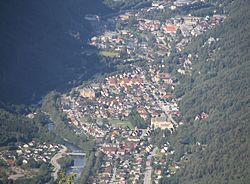
Back ريوكان Arabic ريوكان ARZ Рюкан Bulgarian Rjukan Catalan Rjukan (kapital sa munisipyo) CEB Rjukan Czech Rjukan Danish Rjukan German Rjukan Esperanto Rjukan Spanish
Rjukan | |
|---|---|
 View of the town | |
| Coordinates: 59°52′44″N 8°35′39″E / 59.87891°N 8.59411°E | |
| Country | Norway |
| Region | Eastern Norway |
| County | Telemark |
| District | Aust-Telemark |
| Municipality | Tinn Municipality |
| Established as | |
| Town (By) | 1996 |
| Area | |
| • Total | 2.59 km2 (1.00 sq mi) |
| Elevation | 300 m (1,000 ft) |
| Population (2022)[2] | |
| • Total | 3,003 |
| • Density | 1,160/km2 (3,000/sq mi) |
| Time zone | UTC+01:00 (CET) |
| • Summer (DST) | UTC+02:00 (CEST) |
| Post Code | 3660 Rjukan |
Rjukan (Norwegian: [ˈrʉ̀ːkɑn]) is a town in Tinn Municipality in Telemark county, Norway. The town is also the administrative centre of Tinn Municipality. The town is located in the Vestfjorddalen valley, between the lakes Møsvatn and Tinnsjå. The municipal council of Tinn declared town status for Rjukan in 1996. The town is located about 10 kilometres (6.2 mi) to the west of the village of Miland and about 20 kilometres (12 mi) to the northwest of the village of Tuddal (in Hjartdal Municipality).[4]
The 2.59-square-kilometre (640-acre) town has a population (2021) of 3,003 and a population density of 1,160 inhabitants per square kilometre (3,000/sq mi).[2]
The town was essentially "built from scratch" due to the industrial developments by Norsk Hydro in the 1910s and 1920s. It got its name from the Rjukan Falls west of the town. At its peak, Rjukan was a significant industrial center in Telemark. It became a World Heritage Site under the name Rjukan–Notodden Industrial Heritage Site on 5 July 2015.[5] The town is perhaps best known for the heavy water sabotage operations at the local Vemork hydroelectric power plant during World War II.[6]
Rjukan does not get any sunlight between September and March because the low sun is blocked by the tall Gaustatoppen mountain located directly to the south.[7] In 2013, at a cost of 5 million kr, an art project called the Sunmirror in Rjukan built several large mirrors on the northern mountainside above the town to reflect the Sun down into the town during these dark months. The mirrors illuminate a small portion of the town square each day.[8]
- ^ In the Norwegian language, the word by can be translated as "town" or "city".
- ^ a b c Statistisk sentralbyrå (1 January 2021). "Urban settlements. Population and area, by municipality".
- ^ "Rjukan, Tinn". yr.no. Retrieved 20 August 2023.
- ^ Thorsnæs, Geir; Lundbo, Sten, eds. (1 August 2023). "Rjukan". Store norske leksikon (in Norwegian). Kunnskapsforlaget. Retrieved 20 August 2023.
- ^ "Rjukan-Notodden Industrial Heritage Site". UNESCO World Heritage Centre. Retrieved 22 July 2023.
- ^ Kraglund, Ivar; Kjølås, Harald; Allkunne; Færøy, Frode (25 January 2023), "tungtvannsaksjonene", Store norske leksikon (in Norwegian), retrieved 22 July 2023
- ^ Henley, Jon (6 November 2013). "Rjukan sun: the Norwegian town that does it with mirrors". The Guardian. ISSN 0261-3077. Retrieved 22 July 2023.
- ^ Alexander, Harriet (23 October 2013). "Norwegian town places mirrors on hillsides to shine light into valley". The Daily Telegraph. Retrieved 24 October 2013.
© MMXXIII Rich X Search. We shall prevail. All rights reserved. Rich X Search

